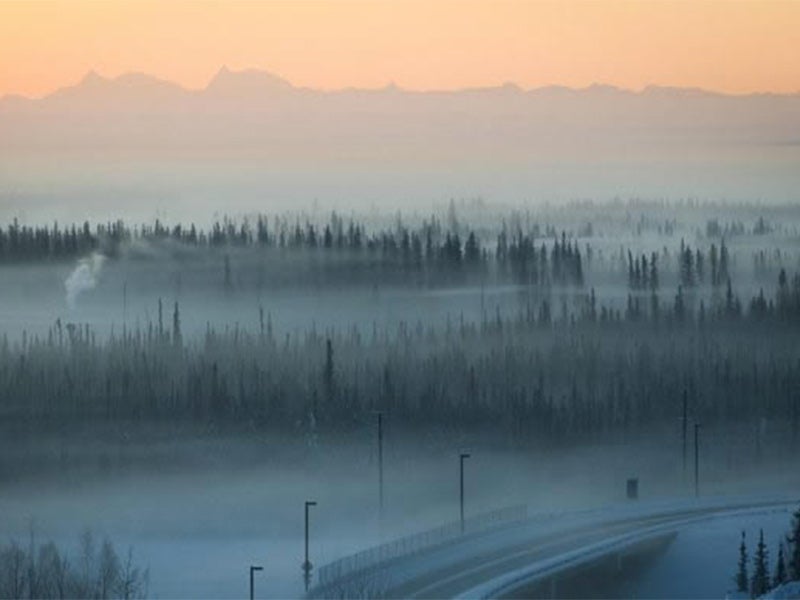Earthjustice stands with western Alaska tribes and families after severe storms devastated entire communities, displacing more than 1,000 residents just before winter. Learn more and how you can help.
Environmental Protection Agency Failed To Enforce Vital Clean Air Protections In Alaska
Fairbanks residents file legal challenge against EPA for Clean Air Act enforcement failures
Contact
A coalition of Fairbanks residents and community groups took legal action against the Environmental Protection Agency (EPA) today, citing failures to protect clean air and public health in Alaska by not enforcing critical components of the Clean Air Act.
When air pollution levels exceed health-based standards, as they do in Fairbanks, the Clean Air Act obligates state officials to submit a plan detailing how they will address the problem. The law requires states to prepare their plans in three years or less, but the State of Alaska has yet to submit a plan more than four years after deadly air pollution levels were identified in Fairbanks. The EPA has a responsibility to compel states to develop and submit overdue plans, a responsibility the agency has neglected for Fairbanks.
The community groups’ lawsuit was filed in federal district court by environmental law firm Earthjustice’s Alaska office.
“Children are the most vulnerable to harm caused by the air pollution in Fairbanks,” said Pamela K. Miller, Executive Director of Alaska Community Action on Toxics. “Studies show that our children are in grave danger from the severe air pollution—they are susceptible to more frequent asthma attacks, their lungs may be unable to develop fully, their energy for learning, exercise, and play is diminished, and their lives are shortened by degenerative heart failure. We have to ask the Borough, our State, and EPA to do better—because we simply can’t continue to allow our children to suffer this harm. It is time for urgent and responsible action.”
“Other communities in the nation have made progress to improve their air quality and make their cities healthy places to live. Yet State of Alaska officials, by contrast, have done almost nothing to address the severe and dangerous air quality—with EPA complicit in their inaction,” said Lou Brown, a Co-Coordinator of Citizens for Clean Air. “The State recently proposed new regulations that do too little to clean up the air pollution. And if past is prologue, it is unlikely that the State will finalize these or other necessary measures anytime soon. In the meantime, the failure to act is hurting the health and welfare of children and families.”
EPA initially set a lenient, three-year deadline for Alaskan officials to develop a plan by December of 2012 to combat the unhealthy air, a deadline the State has failed to meet. The EPA has ignored requests to correct its course and comply with the law.
“There is no disputing that the levels of particulate pollution that occur in Fairbanks cause premature deaths,” stated Dr. Owen Hanley, a Fairbanks pulmonologist. “We know how to prevent the deaths from air pollution. And it is not difficult or expensive. That is why it is astounding that the State of Alaska DEC has repeatedly missed its mandated deadline to even propose a plan to deal with this problem.”
“I live downtown near the power plant, which is Ground Zero for one of the largest and most harmful point sources of air pollution here in Fairbanks” said Teresa de Lima, whose family has been affected by disease linked to pollution. “It is time for every one of us to take action that will move us toward our goal of clean air to breathe.”
The American Lung Association ranked Fairbanks as the ninth dirtiest of 227 metropolitan areas for the deadliest form of fine particle pollution (PM-2.5), a type of air pollution that can penetrate deeply into a person’s lungs and enter their bloodstream. Sources of PM-2.5 in Fairbanks include outdoor burning; wood- and coal-burning heating devices; automobiles and other vehicles; and industrial facilities like coal-fired power plants. The air pollution problem in Fairbanks has worsened since 2009, when state and municipal officials were first advised that soot and smoke levels in Fairbanks were unhealthy and dangerous. Rather than taking necessary measures to address the health issues, the air pollution problems have since worsened and the legislature announced this week plans to provide funding for a new $245 million coal-fired power plant at University of Alaska Fairbanks that will increase harmful emissions of PM-2.5 in the community.
“The Fairbank North Star Borough has some of the worst and most dangerous air quality in the nation,” said Earthjustice attorney Colin O’Brien. “These community groups have joined together to demand that responsible officials address the problems that Borough residents and their families face when simply breathing in Fairbanks.”
More than a thousand health studies have shown that PM-2.5 air pollution causes a wide range of serious health problems, including asthma attacks, chronic respiratory disease, reduction in lung function, hospitalizations and emergency room visits for cardiopulmonary diseases, cancer, and even premature death. One study, conducted by the Alaska Department of Health and Social Services, found that poor air quality led to increased admissions for cerebrovascular disease and respiratory tract infections at Fairbanks Memorial Hospital. PM-2.5 air pollution is of particular danger to children, reducing lung development, causing asthma, and impairing the immune system. The elderly and those with chronic disease also face heightened risk.

Additional Resources
About Earthjustice
Earthjustice is the premier nonprofit environmental law organization. We wield the power of law and the strength of partnership to protect people's health, to preserve magnificent places and wildlife, to advance clean energy, and to combat climate change. We are here because the earth needs a good lawyer.